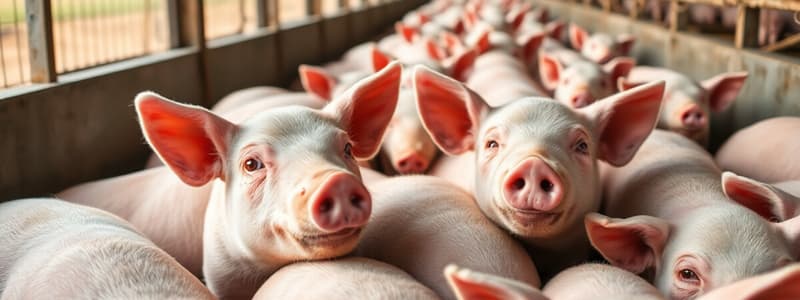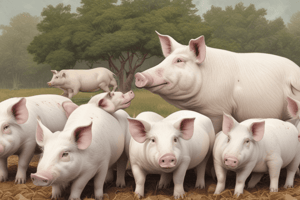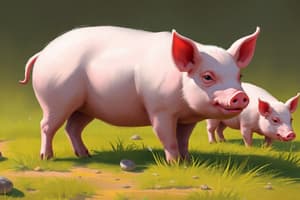Podcast
Questions and Answers
What is the average dressing percentage for pigs compared to other livestock?
What is the average dressing percentage for pigs compared to other livestock?
- Around 75% (correct)
- Around 54%
- Lower than 65%
- Higher than 75%
What is the significance of heritability (h2) in animal genetics?
What is the significance of heritability (h2) in animal genetics?
- It ranges from 1 to 10
- It determines the influence of both environment and genetics
- It reflects the genetic contribution to a phenotype (correct)
- It only indicates environmental influence
Which method is NOT commonly used for heat detection in pigs?
Which method is NOT commonly used for heat detection in pigs?
- Tape recorder method
- Haunch pressure test
- Semen on the snout
- Temperament testing (correct)
What characterizes quantitative traits in pigs?
What characterizes quantitative traits in pigs?
How can the productivity of a pig herd be significantly influenced?
How can the productivity of a pig herd be significantly influenced?
What is the typical duration range of the gestation period in pigs?
What is the typical duration range of the gestation period in pigs?
Which of the following primarily affects qualitative characteristics in pigs?
Which of the following primarily affects qualitative characteristics in pigs?
What is a primary benefit of using artificial insemination in pig breeding?
What is a primary benefit of using artificial insemination in pig breeding?
What does prolificacy in economic traits refer to?
What does prolificacy in economic traits refer to?
Which selection method evaluates traits using a single figure to measure overall performance?
Which selection method evaluates traits using a single figure to measure overall performance?
What is the primary purpose of culling in livestock management?
What is the primary purpose of culling in livestock management?
Which gene is related to disease resistance against enterotoxigenic E. coli F18 bacteria?
Which gene is related to disease resistance against enterotoxigenic E. coli F18 bacteria?
What happens during the independent culling level selection method?
What happens during the independent culling level selection method?
Study Notes
Feed Utilization and Meat Production
- Feed efficiency for pigs ranges from 30-40%, requiring approximately 2.5-3 kg of feed to produce 1 kg of weight gain.
- Dressing percentage of pigs is about 75%, significantly higher than poultry (65%), cattle (54%), sheep (50%), goats (45%), and rabbits (50%).
Genetic Improvement and Reproductive Factors
- Pigs demonstrate rapid genetic improvement due to short reproductive cycles.
- Artificial insemination allows even small-scale pig farmers to access superior genetics.
- Parity distribution plays a crucial role in herd productivity.
Heat Detection Methods
- Various techniques for heat detection include:
- Haunch pressure test
- Riding the back test
- Semen on the snout test
- Teaser method
- Tape recorder method
Pregnancy Cycle
- The gestation period for pigs lasts between 110-120 days, with an average of 114 days (+4).
Characteristics of Pigs
- Quantitative Characteristics: Influenced by both genetics and environment (e.g., Average Daily Gain (ADG), Feed Conversion Ratio (FCR), fertility).
- Qualitative Characteristics: Determined solely by genetics, unaffected by environment (e.g., skin color, ear stance).
Production Improvement Methods
- Environmental improvements (feeds, management, health) are effective for traits with low heritability.
- Selection for traits like feed efficiency, growth, and carcass quality can enhance production.
Heritability (h²)
- Represents the genetic contribution to a trait, expressed as a ratio from 0 to 1.
- h² = 0 indicates environment-only influence; h² = 1 indicates genetics-only influence.
- Heritability classification:
- High: >0.5
- Medium: 0.15 – 0.3
- Low: 0 – 0.15
Selection Methods
- Selection involves choosing breeding parents for future generations.
- Types of selection include:
- Pedigree method: Based on ancestry records.
- Independent culling level: Culling based on a standard for one trait despite performance in others.
- Tandem method: Effective for correlated traits.
- Selection Index: Combines multiple traits into a single performance figure.
Culling Practices
- Culling is the selective removal of less desirable pigs to enhance herd quality.
- Reasons for culling include:
- Age or parity reached maximum productive capacity.
- Meat quality factors related to specific genes and traits.
Economic Traits of Interest
- Prolificacy: High reproductive rates and large litter sizes.
- Growth Rate: Measured as high average daily gain (ADG).
- Feed Efficiency: Optimal feed conversion ratios.
- Carcass Quality: Tailored to meet consumer preferences.
Key Genetic Markers for Traits
- Meat Quality:
- Calcium Release Channel (crc)
- Calpastatin gene (cast) associated with leanness
- Heart-type Fatty Acid Binding Protein (hFabp) for intramuscular fat
- Leptin Receptor (lepr) related to fat deposition
- Reproduction:
- Estrogen Receptor (ESR) linked to litter size
- Prolactin Receptor (PRLR) affecting litter size
- Retinol Binding Protein (RBP) influencing litter size and sperm quality
- Growth Rate:
- Myogenic gene (MYOG) associated with growth
- Disease Resistance:
- FUT1 gene providing resistance to specific bacterial infections
Farrowing Index
- The farrowing index for pigs cataloged at 2.25 kg, representing successful litter weight.
Studying That Suits You
Use AI to generate personalized quizzes and flashcards to suit your learning preferences.
Description
This quiz explores the efficiency of feed utilization in pig meat production, highlighting the remarkable dressing percentage and rapid genetic improvements in pig breeding. It contrasts these factors with other livestock to provide a comprehensive understanding of pork production dynamics.




